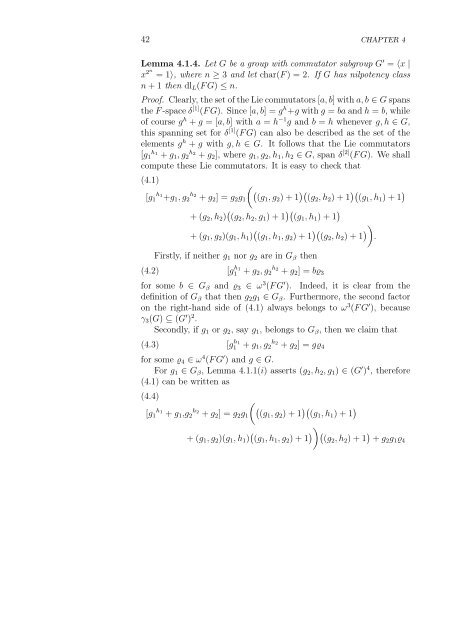On the Derived Length of Lie Solvable Group Algebras
On the Derived Length of Lie Solvable Group Algebras
On the Derived Length of Lie Solvable Group Algebras
You also want an ePaper? Increase the reach of your titles
YUMPU automatically turns print PDFs into web optimized ePapers that Google loves.
42 CHAPTER 4<br />
Lemma 4.1.4. Let G be a group with commutator subgroup G ′ = 〈x |<br />
x2n = 1〉, where n ≥ 3 and let char(F ) = 2. If G has nilpotency class<br />
n + 1 <strong>the</strong>n dlL(F G) ≤ n.<br />
Pro<strong>of</strong>. Clearly, <strong>the</strong> set <strong>of</strong> <strong>the</strong> <strong>Lie</strong> commutators [a, b] with a, b ∈ G spans<br />
<strong>the</strong> F -space δ [1] (F G). Since [a, b] = g h +g with g = ba and h = b, while<br />
<strong>of</strong> course g h + g = [a, b] with a = h −1 g and b = h whenever g, h ∈ G,<br />
this spanning set for δ [1] (F G) can also be described as <strong>the</strong> set <strong>of</strong> <strong>the</strong><br />
elements g h + g with g, h ∈ G. It follows that <strong>the</strong> <strong>Lie</strong> commutators<br />
[g1 h1 + g1, g2 h2 + g2], where g1, g2, h1, h2 ∈ G, span δ [2] (F G). We shall<br />
compute <strong>the</strong>se <strong>Lie</strong> commutators. It is easy to check that<br />
(4.1)<br />
[g1 h1 +g1, g2 h2 + g2] = g2g1<br />
(g1, g2) + 1 (g2, h2) + 1 (g1, h1) + 1 <br />
+ (g2, h2) (g2, h2, g1) + 1 (g1, h1) + 1 <br />
+ (g1, g2)(g1, h1) (g1, h1, g2) + 1 (g2, h2) + 1 <br />
.<br />
Firstly, if nei<strong>the</strong>r g1 nor g2 are in Gβ <strong>the</strong>n<br />
(4.2) [g h1<br />
1 + g2, g2 h2 + g2] = bϱ3<br />
for some b ∈ Gβ and ϱ3 ∈ ω 3 (F G ′ ). Indeed, it is clear from <strong>the</strong><br />
definition <strong>of</strong> Gβ that <strong>the</strong>n g2g1 ∈ Gβ. Fur<strong>the</strong>rmore, <strong>the</strong> second factor<br />
on <strong>the</strong> right-hand side <strong>of</strong> (4.1) always belongs to ω 3 (F G ′ ), because<br />
γ3(G) ⊆ (G ′ ) 2 .<br />
Secondly, if g1 or g2, say g1, belongs to Gβ, <strong>the</strong>n we claim that<br />
(4.3) [g h1<br />
1 + g1, g2 h2 + g2] = gϱ4<br />
for some ϱ4 ∈ ω 4 (F G ′ ) and g ∈ G.<br />
For g1 ∈ Gβ, Lemma 4.1.1(i) asserts (g2, h2, g1) ∈ (G ′ ) 4 , <strong>the</strong>refore<br />
(4.1) can be written as<br />
(4.4)<br />
[g1 h1 + g1,g2 h2 + g2] = g2g1<br />
(g1, g2) + 1 (g1, h1) + 1 <br />
+ (g1, g2)(g1, h1) (g1, h1, g2) + 1 (g2, h2) + 1 + g2g1ϱ4



